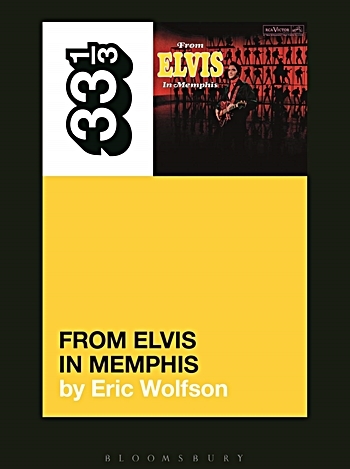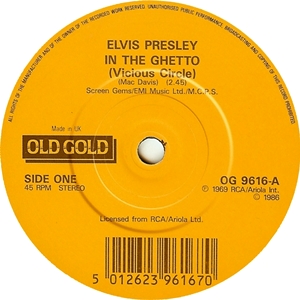 |
 |

From Elvis in Memphis , Eric Wolfson, Bloomsbury Academic, USA, 2020, Softcover/Kindle, ISBN-13: 978-1501355387 – due out November 12, 2020
The Review
Eric Wolfson’s soon to be released, From Elvis in Memphis, fills a void in the Elvis story. While there have been essays about elements of his music canon, for instance, his seminal Sun Sessions, until now there has not been a serious analysis of any of his albums. With this book, we have the long overdue critical exploration of what many regard as his finest album.
The Context Wolfson’s narrative is part-music lesson, part psychological consideration, and part history lesson. And this is necessary, in order to properly understand the circumstances of From Elvis in Memphis. As Wolfson notes, From Elvis in Memphis is very much a comeback album, looking to reposition its singer as once-again relevant. He also effortlessly conjures the atmosphere that was present in Chip Moman’s hip American Sound Studio during the first two months of 1969……warts and all:
His brief reflection on the relevance of the ’68 Comeback Special includes this wonderfully expressive word picture:
Wolfson is a considered thinker and a strong writer. His prose is colourful, often arriving like a bull at a gate, while at other times rising and falling to create expectation, drama, and revelation around the “hot” music Elvis recorded inside American Sound, while outside Memphis was experiencing a bitterly cold winter. The contrast is stark. In setting the context, the author reminds us of Elvis’ walk on Sunset Boulevard with Steve Binder prior to his ’68 Comeback Special, its outcome the motivation for what Elvis would achieve in the 1968-69 period. He also frames that incident in the psychology of Elvis’ life:
At another point, Wolfson observes:
That the American Sound Studio was in Memphis is a key element to the narrative. Memphis’ position in music is explained well in this reflection by Reggie Young:
Wolfson builds on this reflection by noting:
Woven through the narrative are biographical elements of Elvis’ story which help contextualise important events. There is also an engrossing examination of the importance of the “train” to music:
The chapter titles are intriguing and symbolic. They range from The Confession, From Elvis in Paradise, and From Elvis in Purgatory, to The Beautiful Bird, The Cotton Dress, and The Vicious Circle.
The book also includes the author’s research around Elvis’ involvement with the Memphis Boys and among other things, reveals the Memphis Boy Elvis most connected with. No book about Elvis can ignore the Colonel (or can it?). Wolfson ruminates that given ‘Colonel Tom Parker’s central role in Elvis’ life and career, he is conspicuously absent from Elvis’s sessions at American Sound Studio.’ This is given greater gravitas and context when we learn Tom Diskin informed the Colonel that Elvis wanted to handle song selection and publishing without him. In response, the Colonel reportedly replied, “Let him do it and fall on his ass.” The theme is taken further with the author suggesting:
Other stimulating sub-themes dot the narrative. The thorny issue of songwriters (and singer-songwriters) is discussed, with Marty Lacker taking the risk of telling Elvis why his material wasn’t good enough. Both Marty Lacker and George Klein were instrumental in convincing Elvis to record at American Sound Studio. Klein told Elvis:
There is also the revealing account of the studio blow up involving Chips Moman, Freddie Bienstock and Tom Diskin, while readers will also be interested in the (initially) less than complimentary comments made by the leader of the Memphis Horns, Wayne Jackson. Other inclusions are an absorbing account of the connection between Elvis and little known American Delta blues artist, Charley Patton, and Wolfson’s reflection on the tired, but still prevalent today, Elvis as “cultural thief” issue. Wolfson’s ability to separate the real from the fake is apparent in each chapter. For example:
The story also has moments of poignancy. In relation to the death of one of Elvis’ favorite singers, Roy Hamilton, the author notes that while in hospital:
Nothing is left out in the book. Even the album’s front and back covers are subjected to the author’s critical mind. In particular, the back cover attracts a rare instance of criticism (and it is justified).
The Music Wolfson introduces the first American Sound session and the first song on the 1969 album, “Wearin’ That Loved On Look”, in style:
Wolfson’s lateral interpretation of “Wearin’ That Loved On Look” is quickly on display:
The author takes his discourse further:
before going on to discuss the relevance of these layers of home and cleverly segueing into an enlightening consideration of the doo-wop word “shoop” in the song. Wolfson’s account of the story behind “Only the Strong Survive” is compulsive. We also learn that Moman pushed Elvis to do 30 takes before he was satisfied, and, not only that it is the song on the album where the band did not find its own groove, but also:
In further considering the song, Wolfson complex narrative conjures vivid pictures while also provoking thought on the part of the reader:
From Elvis in Memphis always adds to our knowledge of the album and its recording. Regarding I’ll Hold You In My Heart, a song of highs, lows and searing crescendo, we learn that it was the only song on the album ‘not to be sweetened with any overdubs.’ Wolfson also observes that while Dean Martin’s version of the song provides a map of where the song can go, Elvis’ version charts the journey of where it actually takes you. And Wolfson records in detail how Elvis achieved this and reinvented the song. Moreover, he skilfully dissects the song’s evolutionary recording:
Throughout From Elvis in Memphis, Wolfson twists, squeezes, and dissects every sweet and sour element of each recording, uncovering hidden truths and offering important morsals of colorful background information which give new life to what was a challenging and revelatory recording experience for Elvis, Chips Moman, and the Memphis Boys. Almost reductively, Wolfson reveals the soul of From Elvis in Memphis, each sinew of aesthetic experience framed in the cloistered ambience of the lone recording studio. Be it about the Dionysian-like chaos and destruction in Elvis’ delivery of Power of My Love or how recording at American Sound brought out his “country roots”, Wolfson always, albeit, sometimes energetically, sometimes softly, brilliantly illuminates the story, and stimulates the reader’s thought processes. He also challenges our perceptions:
On the issue of Elvis having culturally appropriated African American music, these passages about “Long Black Limousine” are striking:
With lateral thought, Wolfson uses a thematic element from the classic Frank Capra film, “It’s A Wonderful Life” to symbolise the meaning and sense of finality present in the song. As a tale told from the lens of a nameless person (a nobody), in a little town, Wolfson discerns that this allows the song “to underscore Elvis’s own humble origins.” A core strength of Wolfson’s analysis comes from his deeply considered understanding of Elvis and the music he recorded. It is impressive:
Chips Moman standing up to the Elvis’ un-fun Memphis Mafia is instructive, and even more importantly, Moman’s ability to give Elvis constructive criticism and at times blunt feedback, gets to the heart of Elvis being held accountable in the studio for the first time in years:
You are in no doubt when Wolfson starts discussing side 2 of the album:
The author also wastes no time in informing the reader of the change in musical tone/form:
Regarding the often underrated “B” side of In the Ghetto:
In the late 1960’s Elvis recorded a number of songs with a social or moral conscious, including U.S. Male, If I Can Dream, Clean Up Your Own Backyard, and the #1 hit on Cashbox, In the Ghetto. About the latter, Wolfson notes:
About Elvis’ other #1 hit in 1969-70, Wolfson describes the classic, “Suspicious Minds” as having:
The tonal variation evident in the From Elvis in Memphis sessions is highlighted again in Wolfson’s analysis of Mama Liked the Roses (featured in CD editions from 1998 on). It is a song which would later achieve immortality by its inclusion on Elvis’ only RIAA Diamond awarded album, Elvis’ Christmas Album, and is a recording:
The book also features Acknowledgements, Contents, Track Listing, Chapter Notes and Works Cited. EIN wishes to thank Bloomsbury Academic for providing an advance copy of From Elvis in Memphis for review. Verdict: Eric Wolfson’s From Elvis in Memphis is one of the most important examinations of Elvis’ music ever released, and as an examination of a single Elvis album, unique. Its deeply considered perspective presents the authenticity of both the artist and the music. Importantly, it is not just about Elvis. It is a holistic treatise involving the music, the musicians, history, and the socio-cultural context of the time. Through his strong, evocative narrative, Wolfson challenges the reader to consider a fresh interpretation of Elvis’ “new” music. From Elvis in Memphis is a book of insightful riches. This review only scratches its surface.
Click to comment on this review Review by Nigel Patterson.
About the author: Eric Wolfson worked as an artist and musician in Boston and New York City, before settling in Washington, D.C. He works at the Performing Arts Division of the United States Copyright Office in the Library of Congress. He is the only employee in the agency whose desk has a shrine to Elvis.
EIN Website content © Copyright the Elvis Information Network.
Elvis Presley, Elvis and Graceland are trademarks of Elvis Presley Enterprises. The Elvis Information Network has been running since 1986 and is an EPE officially recognised Elvis fan club.
|
|









